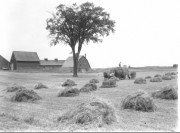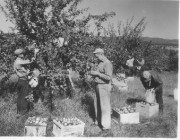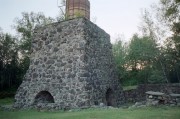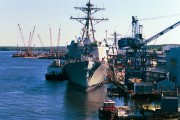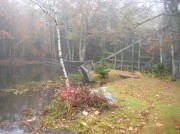
The Remains of a Granite Quarry in Augusta, with Hoist Structure, Mechanism, and a Suspended Granite Block (2002)
The Maine economy has passed through stages typical of most states, with an initial focus on extractive activities (fishing, logging, slate and granite quarrying, other mining, and ice harvesting), and moving from subsistence farming to substantial agricultural development (apples, blueberries [see video in Hiram], potatoes, poultry). More Economic Data
Ice harvesting, from ponds, streams or rivers, became a major industry that was sustained until the widespread use of electricity and refrigerators in the early twentieth century. Now its remnants, like many bygone industries, have become the object of the curious, such as the Thompson Icehouse Museum in South Bristol.
Typical of small-scale industries in many towns include sawmills; barrel and stave mills; grist mills; tanneries; cheese factories; clothing manufacturing; carriage and sleigh factories; canning (corn, seafood) factories; door, sash and blind factories; starch factories; flour-mills; buckwheat mills; etc. [Search on these terms for specific towns.]
Later the economy shifted to larger-scale manufacturing (textiles, wood products – including lumber and paper, and shoes) before maturing into a services oriented economy with its emphasis on retailing, tourism, professional services, government and educational programs, and most recently health care, technology based pursuits, and financial services. Unfortunately, a persistent level of poverty continues to underlie this economy, and variations in the unemployment rate have been particularly difficult for those at or near the poverty level. See how Maine compares to other states on selected measures.
Development and control of electric power has played a major role in both the economic and political life of the state with controversies over private control of public resources and the impact on environmental quality.
Certainly, elements of extraction, agriculture, manufacturing, and services continue in the mix. Traditional marine resource exploitation (fishing, lobstering, shellfish harvesting) coexists with aquaculture and pursuit of “exotic” species such as sea urchins.
Retail sales have shifted dramatically from local, family-owned small businesses to corporate, national and transnational “big box” shopping malls, along with smaller “chain” retailers, such as pharmacies, fast food restaurants, and “quick stop” convenience stores.
Tourism, long a Maine attraction for northeastern city dwellers, has continued to expand. Once a destination by boat or train and trolley, visitors shifted to the automobile after World War II and changed the structure of that industry from a “summer colony” atmosphere to a fast paced competition for food, lodging and entertainment for the highly mobile newcomers.
According to Maine’s Historic Preservation Commission: In the years after the Civil War, Maine’s inland regions witnessed a sharp increase in the number of recreational tourists who came to the area. Initially, most of these people were “sports” in pursuit of the much-praised fishing and hunting experiences that had been extolled in published accounts, and their destinations were often one of the many rustic sporting camps that soon dotted the lakes. As the number of people drawn to the interior increased, however, an entire industry emerged to cater to their needs. In addition to the sporting camp complexes, a considerable number of resort hotels were erected in the late nineteenth and early twentieth centuries that provided not only full accommodations, but also a whole range of recreational activities including golf, tennis, and boating. In time, the logistical problems encountered in reaching many of these inland locations were reduced by expanding rail connections and the widespread use of automobiles on the improving highway system.
Shipbuilding began with the Virginia at the Popham Colony in 1607 and has continued in various forms ever since. Maine built its share of clipper ships, recreational vessels, and warships; and, while not as dominant, maintains that tradition in the twenty-first century. Now, other than naval vessels, large ships, such as the ferry Scotia Prince, cruise ships and oil tankers, that ply Maine waters are built elsewhere.
The state has always been affected by international trade, including the early British appetite for masts and ships and the European market for fish. As capital flowed from Maine to southern states and then to other countries in search of cheaper labor, the textile and shoe industries withered. As the paper industry competes with Scandinavian, Indonesian, and South African producers, resulting forced efficiencies reduce the demand for labor and even for portions of the forests.
Dislocations have usually been resisted, first by businesses and employees alone, then by short-term protection, tax subsidies, and general support from State government through various “development commissions,” “economic development departments,” and partnerships with the tourism industry. However, the larger economic and financial pressures have prevailed, changing business patterns for the State’s nearly 200 year history.
One persistent pattern, poverty and low educational attainment, may hamper the state’s economic growth potential as needed skills are in short supply and the social costs of poverty continue to grow.
More Videos!
Additional resources
See also Fly Rod Crosby.
Maine Historic Preservation Commission, Augusta, Maine. Quotation from National Historic Register file “Dreamhome,” Oxford County, Greenwood and Woodstock.
Hart, Patricia H. Investment Imperative II Survey with 1,000 Maine Businesses: a Joint Research Project to Uunderstand Actions for Future Economic Growth in Maine. Augusta, Me. Maine Development Foundation. 2010.
Maine Science & Technology Foundation. 1998 Maine Science & Technology Report Card: are science and technology innovations in Maine stimulating economic growth in Maine? Augusta, Me. The Foundation. 1999.
Maine Comprehensive Research and Development Evaluation 2008: a report to the Maine Office of Innovation, Department of Economic and Community Development. PolicyOne Research, Inc., RTI International, EntreWorks Consulting. Augusta, Me. Maine Department of Economic and Community Development, Office of Innovation. 2009.
Moreland Fichtner, Donna. Report on Maine’s Nature-based Tourism Initiative: an Initiative of Governor John Elias Baldacci. Augusta, Me. The Task Force. 2010.


